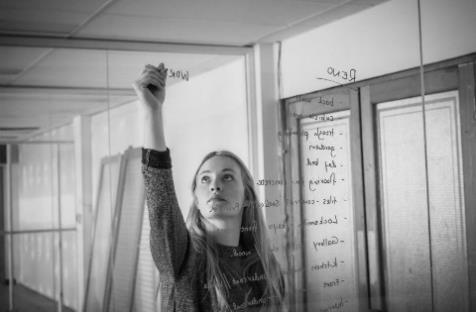The Mill, founded by young creative entrepreneurs, Amber Cronin and Erin Fowler, is Adelaide’s freshest arts hub. Located in the heart of the CBD, The Mill, gives artists the space to pursue their artistic ventures and simultaneously responds to the ever elusive question of the city’s cultural identity.
Although the warehouse has been open mere weeks, the foundations for The Mill have been in the pipeline for over a year. Cronin and Fowler recognized the need to fill a gap in the Adelaide market, for mid-range and affordable space for creative communities. The Mill has woven a tapestry of mixed disciplinary artists, connecting fragmented industries under the one roof and providing the rich foundations for ideas to breathe.
Artist-run initiatives are by no means a new phenomenon and have been part of the mainstream consciousness for communities on the east coast of Australia, for some time now. In an attempt to redefining the city’s identity, the Adelaide government have invested substantial efforts in the reactivation of the city. Yet despite this energy, there are simply too few practical spaces available for emerging artists to create their work.
The lack of artist-run initiatives does not correlate to a lack in their demand, and for Cronin, Adelaide is the perfect place to test out ideas.
‘While other markets on the east coast can at times be flooded, Adelaide is the perfect size for new entrepreneurial types to start their projects and test new ideas with successful outcomes.’
So if there are young people who want to create, what has happened between Adelaide and other major cities in Australia, to leave it in a state of cultural crisis? The issue is complex, however some of the major issues gravitate around building codes and compliancy.
The Mill discovered, that the non-for-profit, low-income business model of artist-run initiatives is not compatible with traditional commercial leases in the CBD. ‘It’s difficult for artist run initiatives to be self-sustainable within the Adelaide CBD without taking on a redevelopment condemned building with a short-term lease that would be unattractive to a commercial tenant,’ Cronin said.
But taking on these empty, older buildings, leaves arts collectives in murky waters.‘The business looses security as the property could be pulled out from under them if a more commercially attractive tenant is given the green light. But even when using a short-term, redevelopment building, generally landlords or building owners are unwilling to invest in any major changes to the building. Depending on the state of the building- this can open up any number of issues itself: building code compliancy, disrepair, fire compliancy, changes to of use of space, and disability access compliancy- which means that a space is rendered unusable for grassroots start-ups.’
Lily Jacobs, General Manager at Renew Adelaide, agrees, noting, the way South Australian government and councils, have interpreted The Building Code of Australia, has traditionally blocked the path for places like The Mill to emerge. However for Jacobs, the issue runs deeper.
‘Nobody ever has any certain answers about what the regulations are and what they mean; it’s very difficult to get consistent answers about what you need to do to be able to use a building. There needs to be a streamlining of that information source, especially when you’re going through different council departments.’
The sheer difficulty in finding a space to house an idea in Adelaide, unfortunately means many young artists are deterred, giving up altogether, or packing up and taking their ideas elsewhere.
‘From my experience artist-run initiatives interstate don’t usually have quite as many difficulties. It’s often a lot easier to access the person who makes the decision or can give you creative solutions to transfer ideas into reality. Traditionally, in Adelaide there has been a reluctance to look at what those solutions could be and use them,’ Jacobs said.
‘If people have to struggle here then why would they stay, when the grass is greener on the other side? Adelaide needs to make the whole process for artist-run initiatives easier, not just building codes, but understanding leases, negotiating with owners, and giving people the space to develop business confidence.’
Jacobs said, in the current environment, The Mill is unique. ‘Amber and Erin are amazing. They didn’t give up, looking for a space for over a year. For most people that’s a huge ask and it certainly shouldn’t have to be that difficult at all’.
Next Wave 2014 artists, Ellen Buttrose, John Pagnozzi, and Jess Miley from b.o.m.b collective, say having a formal space at The Mill, reminiscent of their architectural school studio, has enabled them to commit themselves completely to their work.
‘Working with other artists gives you a sense of community and affirms your position doing creative work. Working in your bedroom or at your kitchen table, can get a bit disillusioning and you start to question yourself,’ Pagnozzi said.
And b.o.m.b is certainly hopeful that if barriers start to fall away, giving rise to more artist-run collectives in Adelaide, there will be a spike in the amount of interesting and innovative work being produced. ‘If we are given a space to play and create, you would think something good would have to come out of it,’ he said.
Creative spaces like The Mill, are a step in the right direction, fostering the practice of emerging artists in Adelaide, and potentially stemming the city’s brain drain. However the next step proves a little more complex; that is breaking down prevailing archetypes of what can be constituted as art.
Working in the cross-disciplinary, expanded field of spatial practice, b.o.m.b are in the process of applying for arts grants in Melbourne, simply because their architectural background, rules them ineligible for traditional arts grants in Adelaide.
‘The Melbourne grants ask for a point of difference, and new experimental practice that expands the usual definition of what public art is. It seems Melbourne is more concerned with where the artwork fits within a broader language of art, the current discourses, whereas Adelaide seems to be very object based. We have a long history of things people can easily identify as art, things like statues, which is very much entrenched,’ Buttrose said.
Pagnozzi believes this risk adverse attitude, is not unique to the arts sector, but is rife across all disciplines in the state. ‘This idea of comfort, where everything is as it is, and everything has its place- a park is a park, a city street is a city street- and anything that diverges from that becomes unknown and people fear it, is engrained in South Australia. I think perhaps, it’s art’s role to try and break through that.’
For Buttrose a greater trust in the competency of emerging artists, would generate an environment in Adelaide where young creatives would want to work. ‘There is a certain idea about what art is, and what design is and it’s ok if it fits within those boxes, but when your idea starts stretching from that, you’re really on your own.’
‘We are not necessarily looking for acceptance, art is meant to provoke debate around ideas. What we need to stay in Adelaide is simply to be given the opportunity and freedom to create,’ Pagnozzi said.
Jacobs, hopes with time, the more artist collectives that are empowered to open, challenging the dominant discourse, the greater the desire will be for young people like the b.o.m.b collective to remain in Adelaide, bringing about real grassroots change, as opposed to top down government solutions for the state’s cultural crisis.
‘The positive reaction to The Mill has been really uplifting, and shows there is a demand for this kind of space in Adelaide. The more alternative projects that are allowed, the more we can break down the prevailing conservative ideas of the public about the legitimacy of artist-run collectives and art,’ Jacobs said.
The government can only go so far in bringing about organic cultural stimulation to the city. At the end of the day however, as Pagnozzi affirmed, it is time for young people to stop worrying about what systems say they can and can’t do, and create the change they want to see and Adelaide deserves.
‘If we constantly worry about the fact that we are Adelaide and that we’re small, or that people aren’t open to emerging art, we are never going to create anything. We just need to do it and whatever the repercussions are of that will hopefully start creating some sort of legitimate change. Sometimes we need to stop idealising our position and just work.’





